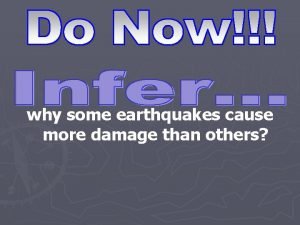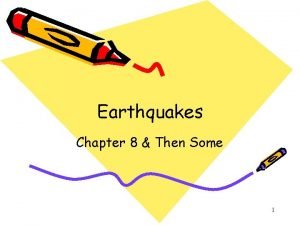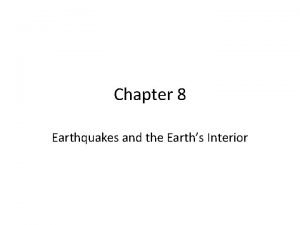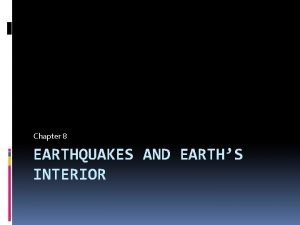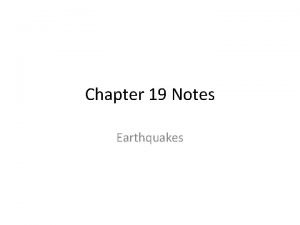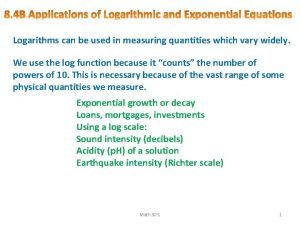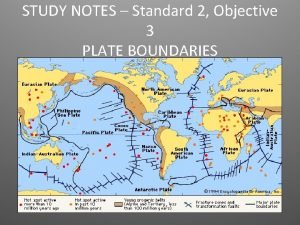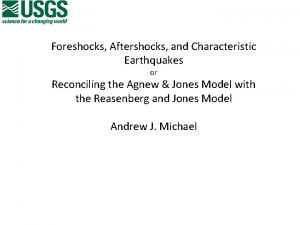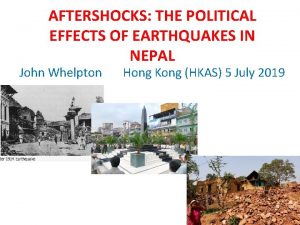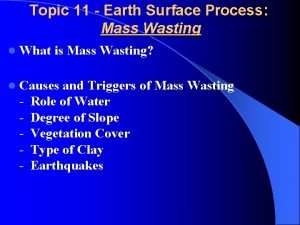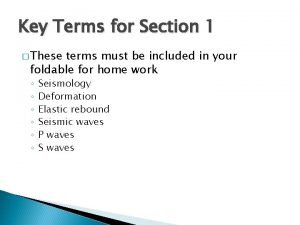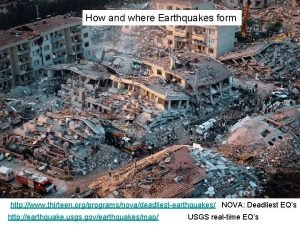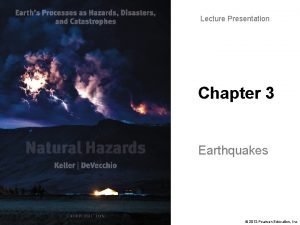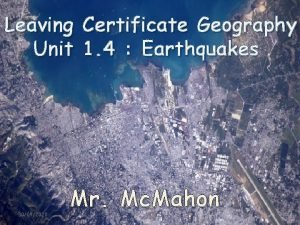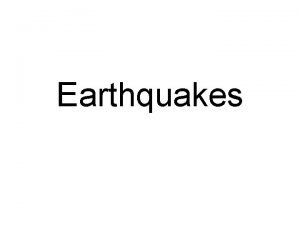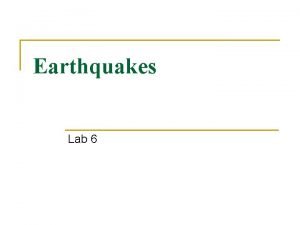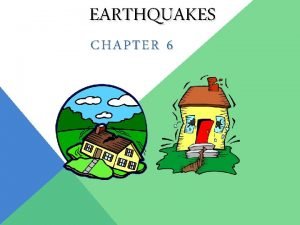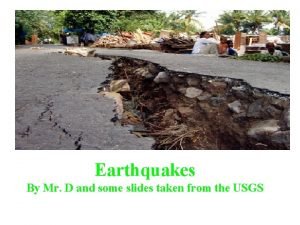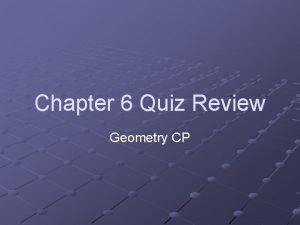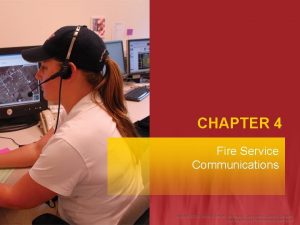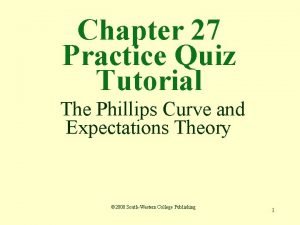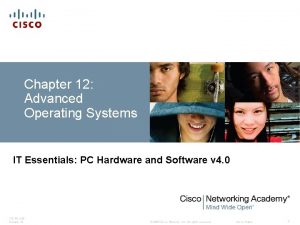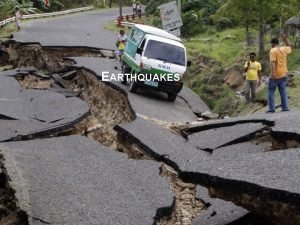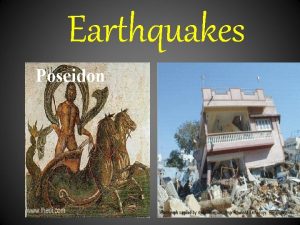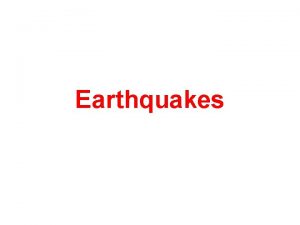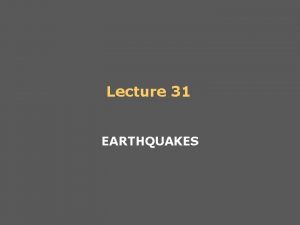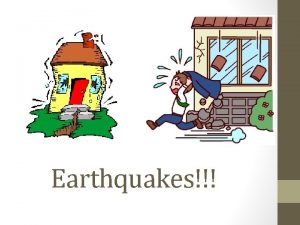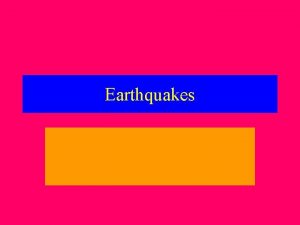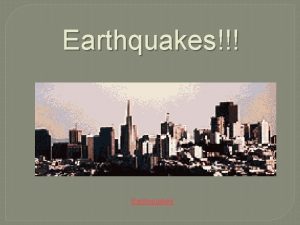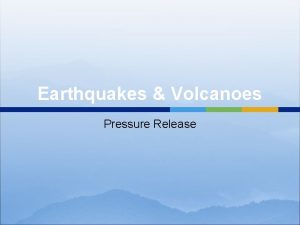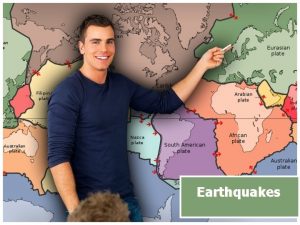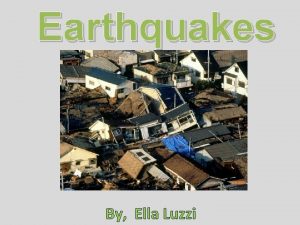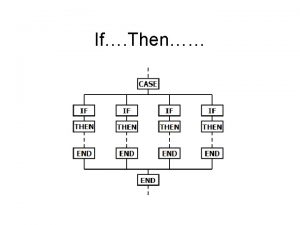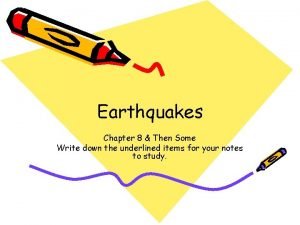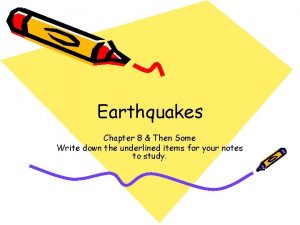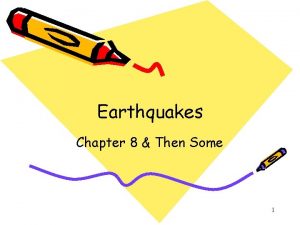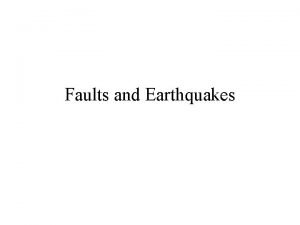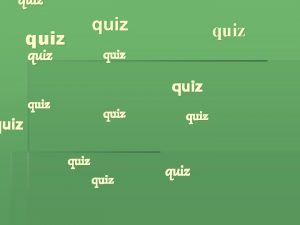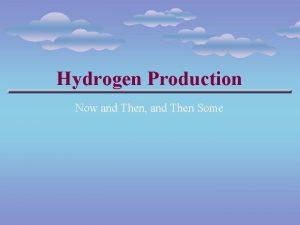Earthquakes Chapter 8 Then Some 1 Quiz 1
























































- Slides: 56

Earthquakes Chapter 8 & Then Some 1

Quiz • • • 1. Most Earthquakes occur along ________. 2. The first seismic waves to arrive are_______. 3. The second seismic waves to arrive are _______. 4. The last seismic waves to arrive are________. 5. Which seismic waves travel the fastest? ______ 6. Which type of seismic wave can move through a solid, liquid or a gas? ________ • 7. Which seismic wave cannot travel through material that is completely liquid? _______ • 8. Which seismic waves are the slowest and the most destructive? ________ 2

Where do Earthquakes occur? • Most earthquakes take place near the edges of tectonic plate. • Earthquakes occur along faults, where blocks of crust move. 3

Earthquake Zones • Earthquakes can occur near the Earth’s surface or far below the surface. • Most earthquakes occur at plate boundaries (in earthquake zones), but some happen at faults located in the middle of tectonic plates. 4

5

Earthquake Locations Around the World 6

Earthquakes in Alabama? ! Surely, you’re kidding? How? Why? 7

The New Madrid Fault • If there is no plate boundary in the middle of the United States, why do these earthquakes take place? • Geologists are beginning to understand the answer. The New Madrid Fault Zone is part of an ancient plate boundary. • In this area, the North American Plate tried to form a divergent plate boundary about 500 million years ago. The splitting stopped before new plates could form. 8

The New Madrid Fault • The faults in the New Madrid Zone are remnants of this old event. Earthquakes occur because the North American Plate is still "settling down". • The faults in the New Madrid Zone do not reach the Earth’s surface. • They are buried beneath thousands of feet of rock and sediment deposited by the Mississippi River. • Geologists have located them by looking at the patterns of earthquakes in the zone. 9

New Madrid Fault Several of the largest earthquakes ever recorded in the United States occurred in the Midwest, far from any plate boundary. These earthquakes took place in an area called the New Madrid Fault Zone, named after the town of New Madrid, Missouri. 10

Alabama’s Earthquake Zone 11

Earthquakes in Alabama • The last earthquake to occur in Alabama was on July 27, 2007. – It measured a 2. 6 on the Richter scale. (A little stronger than the one crazed LSU fans caused in October 9, 1988, when they defeated Auburn 7 -6 for the SEC title. 80, 000 people jumping up & down created surface waves, triggering an earthquake. Imagine that many people jumping up & down on a trampoline. ) • This was not a very strong earthquake, but it was recorded by a seismograph, an instrument used to measure earthquakes. 12

What Causes Earthquakes? • Caused by movement along faults (breaks in the Earth’s surface) • Rock deforms (changes) due to stress • Two types of deformation: – Plastic deformation: bending of rock; no earthquakes created – Elastic deformation: bending of rock until it breaks; causes earthquakes 13

What is Elastic Rebound? • occurs when rock is suddenly returned to its undeformed (original) shape – Example: rubberband snapping back after being stretched • The rock will bend until enough force causes the rocks on either side of a fault to move and release energy. • Think of it as a rubber band being stretched to its limit and released—it snaps back. 14

Elastic Rebound 15

16

3 Types of Faults Associated with Earthquakes PLATE MOTION Transform FAULT TYPE Convergent Strike –Slip Fault Reverse Fault Divergent Normal Fault 17

Strike-Slip Fault occurs at a Transform Boundary 18

19

Reverse Fault occurs at a Convergent Boundary 20

21

Normal Faults occur at Divergent Boundaries 22

23

24

25

Earthquakes and Faults Organizer: Draw the boundary on the plate motion side & the fault moving on the fault type side (label Hanging Wall & Foot Wall) PLATE MOTION FAULT TYPE Transform Boundary: Plates Strike –Slip Fault: Fault blocks move past each other Convergent: Plates push Reverse Fault: Fault blocks move toward each other Divergent Boundary: Plates Normal Fault: Fault blocks move apart 26

Earthquake Energy: Just How Strong Was It Anyway? Earthquake Energy=Seismic Energy 27

How do Earthquake Waves Travel? • Energy released from moving plates & faults travels through the Earth as waves. • Waves travel at different speeds & in different ways, depending on what kind of material they are moving through. 28

Earthquake Energy This energy is called seismic energy and is measured in seismic waves: – Two types of seismic waves: • body waves • surface waves 29

Body Waves: waves that travel through the Earth’s interior • There are two types of body waves: – P-waves – S-waves 30

P and S wave comparison 31

P-waves: primary waves or pressure waves • travel through solid, liquids and gases • fastest waves (travel 5 -8 km/h), arrive first & are first ones to be detected • P-waves cause rock to squeeze and stretch. Imagine a slinky! 32

P-Waves 33

S-waves: secondary waves • second fastest waves; 2 nd to arrive; shear waves • slower than P-waves; travel 3 -5 km/h • S-waves move rock from side to side. • S-waves can’t travel through parts of the Earth that are completely liquid. 34

S-Waves 35

Surface Waves • move along the surface of the Earth • can move up, down & around or side to side • Surface waves move the slowest & cause the most destruction. – Think about it? Where do most people live: on the Earth’s crust or in it? Shouldn’t these waves be the most destructive since they occur where there is more stuff to destroy? 36

37

Surface Waves 38

Seismic Wave Arrival • First- P-waves • Second- S-waves • Third- Surface Waves 39

Measuring Earthquakes Seismographs & Seismograms Wait aren’t those the same? 40

Measuring Earthquakes • Seismographs: instruments used to sense earthquakes • Seismogram: tracing of earthquake movement made by seismograph • Seismologists use seismograms to locate earthquakes. 41

Picture of a Seismograph 42

Time and Location of Earthquakes • Seismologists use seismograms to find the epicenter of earthquakes: – the point on top of the Earth above the true center of an earthquake which is called the focus—it’s inside the Earth. (Also called the hypocenter. ) 43

Seismograms 44

Measuring Earthquakes • Earthquakes are defined by their strength and depth, which is measured at the place the earthquake occurs. • 2 Scales are used to rank the quakes: – Richter Scale—measures magnitude – Mercalli Scale—measures intensity 45

Earthquake strength & intensity • Richter scale: measures magnitude (think strength) of ground motion on a scale of 2. 0 -8. 0 (numbers) • Mercalli scale: measures degree to which an earthquake is felt by people & amount of damage caused, which is known as intensity – Scale of I-XII (Roman Numerals) 46

Magnitude Effects 2. 0 (2 -2. 9 very minor) Only felt by seismograph 3. 0 (3 -3. 9, minor) Felt at epicenter 4. 0 (4 -4. 9 light) Felt by most people in area 5. 0 (5 -5. 9, moderate) Damage at epicenter 6. 0 (6 -6. 9, strong) Widespread damage 7. 0 (7 -7. 9 major) Great, widespread damage 8. 0 or higher (8 & up, great) Catastrophic destruction 47

48

Reading Richter Scale Maps 49

Reading Mercalli Scale Maps 50

51

52

Seismograph • • • A seismograph is an instrument used by scientists to measure earthquakes. Seismologists who study earthquakes can determine when an earthquake started by noting the arrival times of P-waves and S-waves. A seismograph records vibrations in the Earth and determines the strength and location of an earthquake. 53

Chinese Seismograph Ancient Chinese Seismograph. The ball would drop from the dragon to the frog. It told the people from which direction the earthquake came. 54

Seismograms 0 1 2 3 Time in Minutes 4 5 6 7 8 1. How many minutes did it take for the P-Waves to arrive? 2. How many minutes did it take for the S-waves to arrive? 3. How long did the surface waves last? 55

Mercalli Intensity Scale 1. What is the intensity at Monterey? Smith 2. What is the intensity at the epicenter? 3. What is the intensity at San Jose? 4. What is the intensity at Santa Cruz? 5. What is the intensity at Smith? 56
 Why do some earthquakes cause more damage than others
Why do some earthquakes cause more damage than others Quiz 1 earthquakes
Quiz 1 earthquakes Chapter 8 section 2 earthquake measurement answer key
Chapter 8 section 2 earthquake measurement answer key Chapter 8 earthquakes and volcanoes
Chapter 8 earthquakes and volcanoes Chapter 8 earthquakes and earth's interior
Chapter 8 earthquakes and earth's interior Chapter 19 earthquakes
Chapter 19 earthquakes Chapter 8 earthquakes and earth's interior answer key
Chapter 8 earthquakes and earth's interior answer key Chapter 19 earthquakes
Chapter 19 earthquakes In what section of earth do earthquakes happen
In what section of earth do earthquakes happen Btn earthquakes
Btn earthquakes Positive effects of earthquakes
Positive effects of earthquakes Http://earthquake.usgs.gov/earthquakes/map/
Http://earthquake.usgs.gov/earthquakes/map/ A large crack in the earth formed by a river or earthquakes
A large crack in the earth formed by a river or earthquakes Frequent earthquakes in an area may indicate
Frequent earthquakes in an area may indicate Earthquakes
Earthquakes Earthquakes
Earthquakes Mass wasting processes
Mass wasting processes Elastic rebound
Elastic rebound Why do earthquakes occur
Why do earthquakes occur What are the factors of earthquake
What are the factors of earthquake 5 effects of earthquakes
5 effects of earthquakes Rictor scale
Rictor scale Where do earthquakes occur? *
Where do earthquakes occur? * Diastrophism meaning
Diastrophism meaning 10 causes of earthquakes
10 causes of earthquakes Liquefaction occurs when seismic waves cause __________.
Liquefaction occurs when seismic waves cause __________. Normal fault definition
Normal fault definition What is sweetened then soured boiled then cooled
What is sweetened then soured boiled then cooled Then felt i like some watcher of the skies
Then felt i like some watcher of the skies They say it only takes a little faith to move a mountain
They say it only takes a little faith to move a mountain God when you choose to leave mountains unmovable
God when you choose to leave mountains unmovable Countable and uncountable cake
Countable and uncountable cake What are some contact forces and some noncontact forces
What are some contact forces and some noncontact forces Some say the world will end in fire some say in ice
Some say the world will end in fire some say in ice Some say the world will end in fire some say in ice
Some say the world will end in fire some say in ice Some trust in chariots and some in horses song
Some trust in chariots and some in horses song Examples of deductive reasoning
Examples of deductive reasoning Deductive method
Deductive method 9 chemical names and formulas
9 chemical names and formulas Whats the ffa motto
Whats the ffa motto What happened to justice wargrave in chapter 13
What happened to justice wargrave in chapter 13 The great gatsby 4-6 quiz
The great gatsby 4-6 quiz To kill a mockingbird chapters 1-5
To kill a mockingbird chapters 1-5 To kill a mockingbird 1-5 summary
To kill a mockingbird 1-5 summary The outsiders chapter 9 quiz
The outsiders chapter 9 quiz Chapter 4 great gatsby quiz
Chapter 4 great gatsby quiz Describe 2 incidents involving automobiles in this chapter
Describe 2 incidents involving automobiles in this chapter Chapter 1 night quiz
Chapter 1 night quiz Lord of the flies chapter 7 audio
Lord of the flies chapter 7 audio Letters 1-4 frankenstein quiz
Letters 1-4 frankenstein quiz Daniel chapter 7 questions and answers
Daniel chapter 7 questions and answers Chapter 6 quiz 3 geometry answers
Chapter 6 quiz 3 geometry answers Fire service communications
Fire service communications Ap statistics chapter 27 quiz
Ap statistics chapter 27 quiz It essential chapter 12
It essential chapter 12 It essentials chapter 11
It essentials chapter 11 Chapter 1 lesson 1 your total health answer key
Chapter 1 lesson 1 your total health answer key
